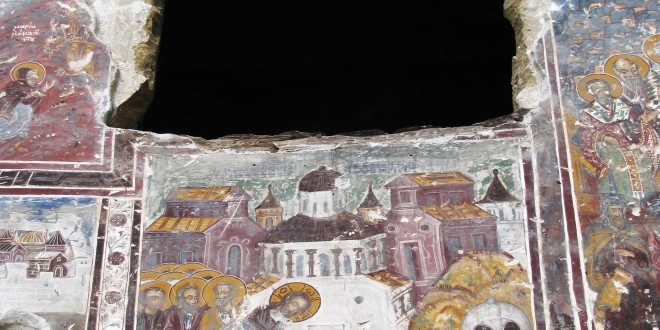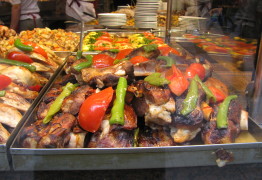I have Fridays off this summer, at least when I’m not grading midterms and finals, so I had imagined a number of weekend getaways. So far, only one has materialized. Last Friday, Sankar and I flew east for an hour and a half toward former Soviet Georgia, stopping just short in Turkey’s Black Sea port of Trabzon.
Trabzon, formerly Trebizond, was the place in which the last Roman loyalists took refuge in 1453, after Constantinople fell to the Muslim Turks. I had been wanting to see this region, known for lush greenery, tea plantings and dramatic history. Legend has it that Jason led his Argonauts along this coast in search of the Golden Fleece, and some say the Amazon race of women warriors hails from this area.
We arrived to overcast skies, apparently quite common, and the play of rain clouds on the city’s numerous concrete buildings was dispiriting. Our rental car, which we had to obtain from a shifty-looking man in the airport parking lot, was a beatup Hyundai with a funny odor inside. The gas meter was on zero, so our first task was finding a petrol station. After that, we navigated contradicting advice on how to reach our hotel, ranging from “Turn left at the first light, and it is right there” to “It’s fifteen kilometers away.” (This estimate was immediately lowered to eight kilometers when my face registered dismay.) Alas, the hotel turned out to be far from any historic city center, a boxy cement structure on damp stretch of coast north of town.
Checking in, we were surprised and taken aback to see scattered around the lobby and restaurant, women draped in black, their faces covered save for the tiniest of slits for their eyes. They were accompanied by short, stout men with long, frizzy black beards and disapproving countenances.
“Where are these folks from,” we asked a waitress in the restaurant.
“Saudi Arabistan and Qatar,” was the answer.
It was the last of a string of less-than-pleasant surprises. The silent women made me feel as if something was wrong with my clothes. And that evening, after a quick trip to the lobby, when I found myself alone in the elevator with one of the men, he promptly turned and stood facing the corner. “It’s like we stumbled into a Taliban convention,” I grumbled to Sankar.
We got up to a cloudy sky Saturday morning and set off a bit grimly for the area’s major attraction. The Sumela Monastery is a series of ancient buildings cut into a steep cliff by 4th century Greek monks. The Turkish goverment has created a national park around this structure, and we arrived in the late morning and began climbing up toward it.
The microclimate reminded me of the Pacific Northwest: great pine trees and moist undergrowth, tall hills, rocky clefts and high humidity. We walked up and up, the path never leveling off (later I decided that was perhaps by design, to avoid standing water that would breed mosquitoes). Our guidebook said the climb would take a half hour, but it took twice that because the air was so thick I kept having to stop and catch my breath. Toward the top, a cloud moved in and we continued in the mist, our feet slipping on the rock pathway.
Finally we got a glimpse of the monastery, clinging to the face of the mountain. That gave me a second wind and soon we were at the top, paying our entrance fees and passing through the set of metal turnstiles that are ubiquitous at every Turkish tourist attraction, no matter how remote.
Inside the monastery walls, one goes up and down steep staircases to peer into chapels, a rock church, a library, and small cells that served as the monk’s bedrooms. The church’s inner and outer walls are decorated with frescoes of the Creation and Christ’s life, dating from the 12th century and open to the elements.
A group of us moved through the monastery together, standing and gazing at the still-colorful paintings, and trying to capture them electronically. I glanced at the others around us. They were mostly Turks, and not-particularly-fit-looking, yet many were holding toddlers that they had apparently hauled up to the top. I was amazed. Could they be members of Turkey’s minuscule Christian population? Perhaps, but the headscarf ladies were certainly Muslim. And there was a Saudi couple, he with shaggy hair, she slender, her silky hem caked with dried mud.
What were the people around me thinking, I wondered. What had drawn them up this rugged path? There seemed to be two impulses at play here, one toward solitary devotion that keeps the outside world at bay, and the other a larger, harmonious spirituality. What would the Greek monks, who built this remote residence to live apart from the world, think of the diverse people now standing in their monastery? And how do we reconcile these opposing instincts in our modern world?







We’ve heard Trabzon is a good place to see, so I’m happy to hear you were able to go. Hopefully, we can fit this destination in our schedule too. =)
I visited Sumela before we got married, about 40 years ago and it was deserted, empty and not a trace of turnstile. It makes me sad to see the face of ‘progress’ but I guess it’s good that more people are seeing these places.